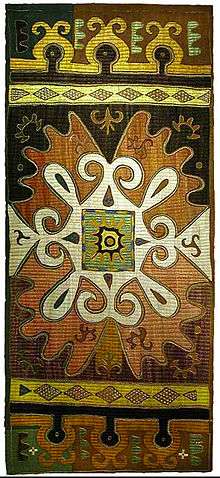Vyshyvanka
Vyshyvanka (Ukrainian: вишива́нка [wɪʃɪˈwɑnkɐ] or виши́ванка [wɪˈʃɪwɐnkɐ][1]) is a casual name for the embroidered shirt in Ukrainian[2][3][4][5] and Belarusian[6][7][8] national costumes. Ukrainian vyshyvanka is distinguished by local embroidery features specific to Ukrainian embroidery.[3]
.jpg)
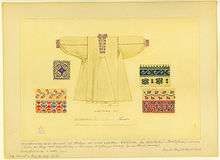
Vyshyvanka is not present in the traditional Russian women's costume with the sarafan consisting of a long full skirt hanging just below the arms with straps or an extremely abbreviated bodice that secures it over the shoulders.[5]
Etymology
In English translations of Ukrainian texts, the word "vyshyvanka" is a loanword.[9] Same way as kilt speaks about its Scottish origin, or moccasins attribute to American Indians heritage, vyshyvanka proudly defines Ukrainian people.[10]
The term originated from the East Slavic word "vyshyvka" meaning "stitch patterns".
In Ukraine
Embroidery
The embroidery is a fundamental element of the Ukrainian folk costume.[11]:16 Ukrainian vyshyvanka is distinguished by local embroidery features specific to Ukrainian embroidery:
The vyshyvanka not only speaks of its Ukrainian origin but also of the particular region in which it was made. The knowing eye could detect where a person hailed from by the clothes on their back. Embroidery is thus an important craft within Ukraine and different techniques exist to suit local styles with their own particular patterns and colours. Traditionally, the thread was coloured according to local formulas using bark, leaves, flowers, berries and so on. In this way, the local environment is literally reflected in the colour of the embroidery.
— JJ Gurga, Echoes of the Past: Ukrainian Poetic Cinema and the Experiential Ethnographic Mode[3]
In Ukrainian embroidery, black, red, and white colours are basic, and yellow, blue, and green are supplementary.[11]:278
On the territory of Ukraine, embroidery existed already in the 5th century B.C, and was a creation of Scythian fine art.[11]:18 Ukraine is famous throughout the world for its highly artistic embroidery.[11]:16 It is important for the embroiderer today to use folk art as a source without altering stitches or colours because every change devalues a piece of embroidery and distorts it.[11]:278
Artistic Influence
Other national dresses
Southern Russian dress, which shows a propensity for bright, polychromatic garments, was most certainly affected by the influence of vividly coloured Ukrainian costume from the significant influx of Ukrainian settlers since the 17th century.[12]
High fashion
During Paris Fashion Week 2015, Ukrainian fashion designer Vita Kin was featured in Vogue magazine[13] and Harper's Bazaar for introducing vyshyvankas as modern Bohemian style designs[14] that attracted fashion icons like Anna Dello Russo, Miroslava Duma, and Leandra Medine.[15]
In its US May issue Vogue wrote that the vyshyvanka has "made waves far past the Eastern European country".[16] The Times of London declared it "this summer's [2016] most sought-after item of clothing", soon following was the New York Times who advised readers to stock up on this "top of summer" fashion.[16] French actress Melanie Thierry wore a vyshyvanka at the 2016 Cannes Film Festival.[16] Queen Máxima of the Netherlands wore a vyshyvanka dress when visiting the 2016 Summer Olympics.[16]
Meaning
Traditional beliefs
Vyshyvanka is used as a talisman to protect the person wearing it and to tell a story.[17] A geometric pattern weaved in the past by adding red or black threads into the light threads, which was later imitated by embroidery, was believed having the power to protect a person from all harm.[11]:278
Patriotism
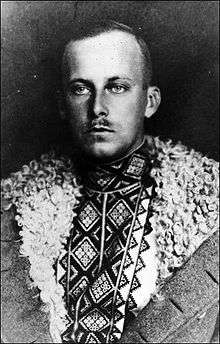
Archduke Wilhelm of Austria was a Ukrainian patriot who preferred wearing the vyshyvanka and was therefore known in Ukrainian as Vasyl Vyshyvanyi (Basil the Embroidered). The Vyshyvanoho Square was named in his honour in the city of Lviv.
Vyshyvanka and other national symbols became extremely popular in Ukraine following Euromaidan, including in LGBT+ communities signalling their belonging to the nation.[18]
Celebration
Vyshyvanka Day originated in 2006 at Chernivtsi National University by its student Lesya Voronyuk and gradually became international as the International Day of Vyshyvanka.[19][20] It is celebrated on the third Thursday of May.[21][19] It is intended to unite all Ukrainians over the world, regardless of religion, language they speak or their place of residence.[22] It is a flash mob holiday, which is not attached to any public holiday or feast day.[23] On this day many Ukrainians wear vyshyvankas to demonstrate commitment to the idea of national identity and unity and to show their patriotism. State officials, including municipal, court, and the government officials and the head of the state,[24] may take part in celebration.
In 2018, the Appeal Instance of the Ministry of Economic Development and Trade of Ukraine conducted a research and came to the following conclusions:[25]
[T]he word combination "Vyshyvanka Day" means the holiday dedicated to Ukrainian ethnic embroidered cloth and entered to Ukrainian culture as the name of a national holiday of Ukrainian consciousness, patriotism, and the spirit of unity of the people symbolized by Ukrainian vyshyvanka.
The word combination "Vyshyvanka Day" invokes in minds of the citizens the only association – the holiday dedicated to vyshyvanka, which is celebrated in Ukraine, and now also abroad, yearly in a certain day of May. The holiday of Vyshyvanka Day gained symbolical meaning and is already an international event which spreads the idea of Ukrainian identity in the world, popularises Ukrainian culture and traditions, aids formation of Ukrainian national consciousness, nurturing patriotism and unity of Ukrainian people. […]
The celebration of Vyshyvanka Day occurs yearly with participation of citizens, non-governmental organisations, state authorities, and is widely celebrated by the society by wearing vyshyvankas and arranging various events […]
In Belarus
Celebration
Gallery
Ukrainian Vyshyvanka
.jpg) Ruthenian immigrants to Canada in 1911 in traditional garment.
Ruthenian immigrants to Canada in 1911 in traditional garment.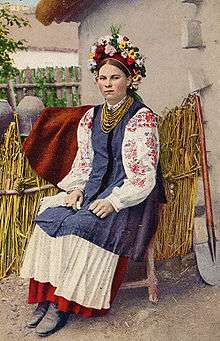 A postcard printed in 1916 featuring a Ukrainian peasant lady in vyshyvanka and traditional wreath.
A postcard printed in 1916 featuring a Ukrainian peasant lady in vyshyvanka and traditional wreath.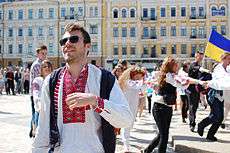 At vyshyvanka parade – a popular event in modern Ukraine.
At vyshyvanka parade – a popular event in modern Ukraine.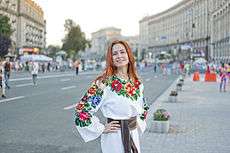 Bukovina-style vyshyvanka.
Bukovina-style vyshyvanka.
See also
References
- "Ukrainian Language Dictionary" (in Ukrainian). Potebnia Institute of Linguistics. Retrieved 2019-02-25.
- Karolina Koziura (Spring 2014). "Everyday Ethnicity in Chernivtsi, Western Ukraine". Anthropology of East Europe Review. Poland: Maria Curie-Sklodowska University. 32 (1). Archived from the original on 2014-06-04. Retrieved 2016-01-30.
- JJ Gurga (September 2012). Echoes of the Past: Ukrainian Poetic Cinema and the Experiential Ethnographic Mode (PDF) (Ph.D.). University College London (UCL). pp. 189–190. Archived (PDF) from the original on 2015-10-22. Retrieved 2016-01-30.
- Filonik, Svitlana (2013). Gender Assignment to Loanwords in Ukrainian (PDF). Proceedings of the 2013 annual conference of the Canadian Linguistic Association. Canadian Linguistic Association. p. 2. Archived (PDF) from the original on 12 October 2019.
- Pereltsvaig, Asya (2017). "Languages of Northern Eurasia". Languages of the World: An Introduction. Cambridge: Cambridge University Press. p. 86. doi:10.1017/9781316758854.006.
- Elena Gapova (2017). "Things to Have for a Belarusian: Rebranding the Nation via Online Participation" (PDF). Studies in Russian, Eurasian and Central European New Media (digitalicons.org). Western Michigan University (17): 47–71. Archived (PDF) from the original on 2018-10-16. Retrieved 2019-02-25.
- "Makei: Vyshyvanka is a national symbol for Belarusians". BelTA. 2017-06-23. Archived from the original on 2017-06-28. Retrieved 2019-02-25.
- "Vyshyvanka to be artistic centerpiece of Independence Day celebrations in Belarus". BelTA. 2016-07-01. Archived from the original on 2016-07-03. Retrieved 2019-02-25.
- Hromova, Viktoriia (2017). "Лінгвокультурні лакуни українсько-англійського перекладу: засоби подолання проблеми безеквівалентності" [Linguocultural Lacunae of Translation from Ukrainian into English: Means for Overcoming the Problem of Absence of Equivalent]. Philological Studies (in Ukrainian). Odesa I. I. Mechnikov National University (8): 26–27. Archived (PDF) from the original on 12 October 2019. Retrieved 12 October 2019.
- V. I. Harapko (2017). Теорія і практика перекладу: курс лекцій з дисципліни для студентів денної форми навчання напряму підготовки 6.020303 «Філологія* (англійська)» [Theory and Practice of Translation: Course of Lectures in Discipline for Full-Time Students Studying 6.020303 "Philology* (English)"] (PDF). Mukachevo: Mukachevo State University. p. 18. Archived (PDF) from the original on 12 October 2019.
- Odarchenko, Petro; Carynnyk, Halyna, eds. (1992). Ukrainian Folk Costumes (PDF) (in Ukrainian and English). Translated by Paszczak-Tracz, Orysia. Toronto — Philadelphia: the World Federation of Ukrainian Women's Organizations. Folk Art Committee. LCCN 90-071681. Archived (PDF) from the original on 14 October 2019.
- Condra, Jill (2013). Encyclopedia of National Dress: Traditional Clothing Around the World. ABC-CLIO. p. 624. ISBN 978-0-313-37636-8.
- Liana Satenstein (Apr 28, 2015). "Your Favorite Bohemian Garb Is Actually Traditional Ukrainian Costume". Vogue. Retrieved 2015-04-28.
- Tara Lamont-Djite (Apr 14, 2015). "We're Obsessed:Vita Kin Introduces The Perfect Bohemia". Harper's Bazaar. Retrieved 2015-04-14.
- "DESIGNERS TO WATCH: Vyshyvankas by Vita Kin – Traditional Ukrainian Chic". Fashion For Fashionlovers. May 14, 2015. Archived from the original on May 29, 2015. Retrieved May 14, 2015.
- Vyshyvanka: Ukraine's national costume conquers the catwalk, Yahoo! News (23 August 2016)
- "У Києві відкрилася виставка вишиванок з усієї України (Vyshyvanka exhibition in Kyiv)". 1TV. 2015-09-11. Archived from the original on 2015-09-25. Retrieved 2016-01-29.
- Plakhotnik, Olga (2019). Imaginaries of Sexual Citizenship in Post-Maidan Ukraine: A Queer Feminist Discursive Investigation (PDF) (PhD). OU. p. 120. Archived (PDF) from the original on 14 October 2019.

- "Ukraine marks Vyshyvanka Day on May 18 (Video)". UNIAN. 18 May 2017. Archived from the original on 10 September 2018. Retrieved 14 October 2019.
- Ivanova, Natalia (18 May 2019). "Multicolored Vyshyvanka Parade in Kharkiv". Kharkiv Observer. Archived from the original on 21 June 2019. Retrieved 14 October 2019.
- Rena Darsania (2015-06-04). "Poltava celebrated the Day of vyshyvanka". PoltNTU press. Archived from the original on 2016-05-01. Retrieved 2016-05-01.
- Information and Communication Department of the Secretariat of the CMU (2015-05-21). "Cabinet of Ministers Secretariat celebrates Vyshyvanka Day". Government portal. Archived from the original on 2016-01-29. Retrieved 2016-01-30.
- "Deputy Minister of Information Policy Tetiana Popova Participates in Press Conference Dedicated to Vyshyvanka Day". Ministry of Information Policy of Ukraine. 2015-04-21. Archived from the original on 2016-01-29. Retrieved 2016-01-30.
- "Our vyshyvanka unites the country - President during the flashmob on Vyshyvanka Day in Dnipro". Official website of the President of Ukraine. 2018-05-17. Archived from the original on 2018-09-13. Retrieved 2018-09-13.
- "The Decision No. 1151 of the Ministry of Economic Development and Trade of Ukraine". 2018-08-17. Archived from the original on 2018-09-13. Retrieved 2018-09-13.
External links



